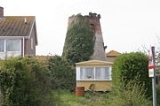
East Wittering Windmill
Encyclopedia
East Wittering Windmill is a grade II listed tower mill
at East Wittering
, Sussex
, England
which is derelict.
and two Common sails. The beehive cap was winded by a fantail
. The sails were set with the aid of a travelling stage. The mill drove two pairs of underdrift millstone
s. The derelict tower stands today.
References for above:-
Tower mill
A tower mill is a type of windmill which consists of a brick or stone tower, on top of which sits a roof or cap which can be turned to bring the sails into the wind....
at East Wittering
East Wittering
East Wittering is a coastal village in the Chichester district of West Sussex, England. The eastern half of the village lies within the civil parish of East Wittering and Bracklesham, while the western half lies within the boundary of West Wittering civil parish...
, Sussex
Sussex
Sussex , from the Old English Sūþsēaxe , is an historic county in South East England corresponding roughly in area to the ancient Kingdom of Sussex. It is bounded on the north by Surrey, east by Kent, south by the English Channel, and west by Hampshire, and is divided for local government into West...
, England
England
England is a country that is part of the United Kingdom. It shares land borders with Scotland to the north and Wales to the west; the Irish Sea is to the north west, the Celtic Sea to the south west, with the North Sea to the east and the English Channel to the south separating it from continental...
which is derelict.
History
East Wittering Windmill was first mentioned in 1810. The mill was working by wind until 1895, and the sails were removed in 1896. The cap was blown off in 1931. The derelict tower retained some machinery in 1974, but was burnt out in May 1975, with the windshaft falling within the tower.Description
East Wittering Windmill is a four storey cement rendered brick tower mill. It had two Spring sailsWindmill sail
Windmills are powered by their sails. Sails are found in different designs, from primitive common sails to the advanced patent sails.-Jib sails:...
and two Common sails. The beehive cap was winded by a fantail
Windmill fantail
A Fantail is a small windmill mounted at right angles to the sails, at the rear of the windmill, and which turns the cap automatically to bring it into the wind. The fantail was patented in 1745 by Edmund Lee, a blacksmith working at Brockmill Forge near Wigan, England, and perfected on mills...
. The sails were set with the aid of a travelling stage. The mill drove two pairs of underdrift millstone
Millstone
Millstones or mill stones are used in windmills and watermills, including tide mills, for grinding wheat or other grains.The type of stone most suitable for making millstones is a siliceous rock called burrstone , an open-textured, porous but tough, fine-grained sandstone, or a silicified,...
s. The derelict tower stands today.
Millers
- Robert Woodman 1845
- William Stevens 1855
- T Souch 1866
- R H Sparkes 1870
- E Redman 1887
- Richard Stevens 1887 - 1895
References for above:-

